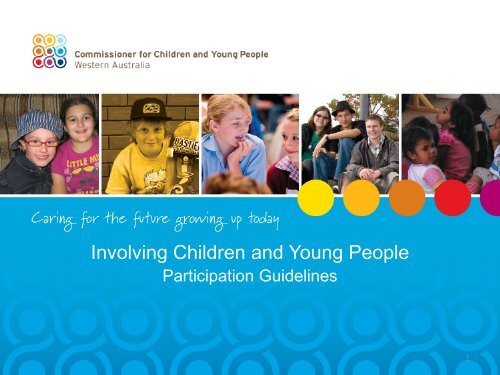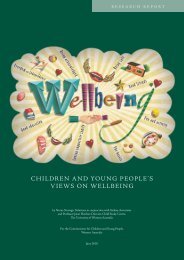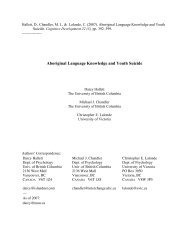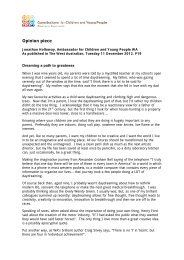Involving Children and Young People - Commissioner for Children ...
Involving Children and Young People - Commissioner for Children ...
Involving Children and Young People - Commissioner for Children ...
You also want an ePaper? Increase the reach of your titles
YUMPU automatically turns print PDFs into web optimized ePapers that Google loves.
<strong>Involving</strong> <strong>Children</strong> <strong>and</strong> <strong>Young</strong> <strong>People</strong>Participation Guidelines1
Welcome tothe seminar <strong>Involving</strong><strong>Children</strong> <strong>and</strong> <strong>Young</strong><strong>People</strong>Tuesday 9 April 2013Presenters:Marketa DreslerLorilee Gale
Program Outline• Goals <strong>for</strong> today’s seminar• Role of the <strong>Commissioner</strong>• Participation Guidelines• Guest presentation – Kate Pitt <strong>and</strong> Nola Broughton,NgalaBreak• Guest presentation – Li<strong>and</strong>a Gibson <strong>and</strong> NatashaAnnan, City of Subiaco• Sharing session• Evaluation
Goals <strong>and</strong> expectations <strong>for</strong> today’s seminar• Reflect on CCYP’s participation guidelines <strong>and</strong> otherparticipation resources• Hear from guest speakers about their participationexamples with a special focus on younger children –up to 12 years of age• Share past experiences with participation
<strong>Commissioner</strong> <strong>for</strong> <strong>Children</strong> <strong>and</strong> <strong>Young</strong> <strong>People</strong>• <strong>Commissioner</strong> <strong>for</strong> <strong>Children</strong> <strong>and</strong> <strong>Young</strong> <strong>People</strong> Act2006• Priority <strong>and</strong> special regard to:- Aboriginal children <strong>and</strong> young people- <strong>Children</strong> <strong>and</strong> young people vulnerableor disadvantaged s.20(1)(a)• Independent statutory office that reports directly toParliament.• Convention on the Rights of the Childs.20(1)(b)
Participation - <strong>Commissioner</strong>’s responsibilities• Promote the participation of children <strong>and</strong> youngpeople s.19(b)• Encourage agencies to seek the participation ofchildren <strong>and</strong> young people s.19(b)• Develop participation guidelines to be used byagencies s.20(1)(d)
<strong>Involving</strong> children <strong>and</strong> young people –ExamplesHigh-level consultation with children <strong>and</strong> young people:• Federal Inquiry into Cyber Safety (2010)• National Fly In Fly Out-Inquiry (2011)Involvement in local projects <strong>and</strong> on committees:• New <strong>Children</strong>’s Hospital Project YAC• Review of the <strong>Commissioner</strong> <strong>for</strong> <strong>Children</strong> <strong>and</strong> <strong>Young</strong> <strong>People</strong> Act• Advisory Committees• Participation examples published on the CCYP website – from arange of agencies
The Participation Cycle
The Participation Cycle in action: Review of the<strong>Commissioner</strong> <strong>for</strong> <strong>Children</strong> <strong>and</strong> <strong>Young</strong> <strong>People</strong>Act 2006 consultationsStep 1: DecidingHave a clear idea of what you want to achieve. The scope <strong>for</strong>involvement is enormous <strong>and</strong> should consider things such as:– Are you looking to improve a program?– Do you want to consult with children <strong>and</strong> young people toin<strong>for</strong>m policy development?– Are you looking <strong>for</strong> a creative or innovative perspective?– What sort of timeline or budget do you have?
Step 2: PreparingConsider:– Which children <strong>and</strong> young people will you involve –thosedirectly affected by your services? Future members? Anorganised pre-existing group (such as a sporting team orschool class) or an opportunity that’s open to all children of aparticular age group?– Do you have the support of adult coordinators that work withthese groups? And do they have the capacity to assist you?– How will your methods <strong>and</strong> activities be appropriate to theage, background, interests of the participants?
Step 3: Doing itConsider:– Being very clear about timeframes <strong>and</strong> expectations– Tell children <strong>and</strong> young people what will happen as a resultof their participation <strong>and</strong> what their actual influence will be– Ensure that all your paperwork is done – permission <strong>for</strong>ms,photo consent <strong>for</strong>ms– Make sure all participants know who will be looking afterthem, <strong>and</strong> who to go to if they have a concern– Make it challenging but achievable <strong>and</strong> ensure there isopportunity to give them appropriate celebration <strong>and</strong>recognition
Step 4: Following up– Ensure that there is adequate resources to review <strong>and</strong>evaluate the project <strong>for</strong> your own purposes– For the participants, acknowledge all the elements of theirparticipation – attendance, contribution, achievements,outcomes– Acknowledge young people personally, but also publiclythrough your newsletters or websites if possible– Ensure you know <strong>and</strong> they know what you’ll do withfeedback – how will you respond or address their ideas?– Take on board any other feedback or concerns fro the youngpeople involved
• Architecture students reported that they had never expected tolearn so much from young children, <strong>and</strong> were now more awareof the capacity children had to contribute to both creative <strong>and</strong>practical aspects of the built environment• “Through iBuild, I discovered that children have an entirelydifferent way of thinking <strong>and</strong> through them we have the abilityto redefine our methods of design, opening new doors.” –architecture student
720 ABC Perth Bright <strong>Young</strong> Reviewers – 2011AWESOME Festival• Eight young reviewers aged between eight <strong>and</strong> 12 attended theAWESOME Festival <strong>for</strong> a behind-the-scenes tour, guided by AWESOME<strong>and</strong> 720 ABC Perth staff.• Afterwards, they were given a deadline to deliver written reviews to720 ABC Perth to be published on its website.• As well as being AWESOME’s target audience, this age group waschosen because at this age, children are able to write critically <strong>and</strong>analytically.• Several local papers in areas where the young people live wrote storiesabout their involvement.
Guest presentationKate Pitt <strong>and</strong> Nola BroughtonNgala
<strong>Involving</strong> young children in decision making
<strong>Involving</strong> young children indecision makingNgala Early Learning <strong>and</strong> Development Service (ELDS)Play is the foundation of our curriculum. Play, wheninterwoven with intentional teaching, provides a context<strong>for</strong> learning. Through play, children make connectionsbetween prior experiences <strong>and</strong> new opportunities tolearn as they discover, create, improvise <strong>and</strong> imagine.Our play environments encourage <strong>and</strong> engage childrento create social groups, test out ideas, challenge eachother’s thinking <strong>and</strong> build new underst<strong>and</strong>ings.
<strong>Involving</strong> young children indecision makingThe play environments cater <strong>for</strong> differentcapacities <strong>and</strong> learning styles, <strong>and</strong> invitechildren <strong>and</strong> families to contribute ideas,interests <strong>and</strong> questions. These welcomingspaces provide a supportive environmentwhere children can ask questions, solveproblems <strong>and</strong> engage in critical thinking.
<strong>Involving</strong> young children in decision makingKey factors of Ngala’s Early Learning <strong>and</strong> DevelopmentService (ELDS) philosophy includes:Respecting, valuing <strong>and</strong> trusting children.Seeing children as capable <strong>and</strong> active participants intheir own learning.This belief is embedded in all our practices, <strong>and</strong> these beliefs arealso an important part of the National Early Years LearningFramework.Ngala ELDS had the opportunity to be a trial site <strong>for</strong> the EYLF.
<strong>Involving</strong> young children in decision makingDecision making skills used by theeducator involving the child:• Secure base/safe <strong>and</strong> secure relationship with educator.• Listening <strong>and</strong> observing carefully.• Respecting child’s play <strong>and</strong> conversation.• Open-ended questioning to gain child’s perspective.• Open ended resources to allow child freedom to exploreown interests.• Problem solving <strong>and</strong> engagement.• Presentation of all resources at child’s level.
<strong>Involving</strong> young children inPlay Areas:decision makingToys are displayed on shelves, baskets,mats <strong>and</strong> tables, within a child’s reach, in aninviting <strong>and</strong> attractive manner; to stimulatecreativity <strong>and</strong> imagination.
<strong>Involving</strong> young children in decision making• <strong>Children</strong> are offered choices throughout the day. Thisincludes where they would like to play, such as indoorsor outdoors (as the door adjoining the two remain openall day).• <strong>Children</strong> also have choice of when to join morning tea,lunch <strong>and</strong> afternoon tea. All routines <strong>and</strong> play areoffered individually <strong>and</strong> in small groups to ensure thechildren are listened to, engaged with <strong>and</strong> learning issupported.
<strong>Involving</strong> young children in decision makingDecision making skills used by theeducator involving the child:• Respect <strong>for</strong> importance of child’s play, interests <strong>and</strong>learning.• Valuing children, listening <strong>and</strong> following child’s lead.• If child chooses not to come inside we would put herlunch in the fridge <strong>and</strong> offer again later.• Time. Long periods of time to engage in play.• Reminding children that choices do haveconsequences.• Explaining.
<strong>Involving</strong> young children in decision makingDecision making skills used by theeducator involving the child:• Knowing the child, knowing the child’sbackground/home life.• Listening intently to child.• Following child’s lead.• Problem solving.• Individual play.• Intentional teaching.• Scaffolding.• Emergent curriculum (reflecting <strong>and</strong> extending child’splay in the moment).
<strong>Involving</strong> young children indecision makingDecision making skills used by the educator the child has beeninvolved in:• Open-ended questioning• Problem solving• Trust <strong>and</strong> respect• ScaffoldingTime out is not used as a behaviour guidance technique atNgala ELDS. We educate <strong>and</strong> teach the children acceptablebehaviours.
ScaffoldingScaffolding involves educators working withchildren firstly by identifying what childrenalready know about something <strong>and</strong> then byusing intentional teaching strategies likedemonstrating, modelling, questioning,problem solving, planning <strong>and</strong> explainingso the can help children move to a new levelof underst<strong>and</strong>ing.
Examples of scaffoldingBrief examples include:• Babies: At mealtimes the child is given a spoon to feedthemself with, the educator has a separate spoon toassist.• 1-2 year olds: This may be acknowledging the child’semotions <strong>and</strong> providing a suitable outlet. For example ifa child is jumping on the couch, we would let them knowcouches are <strong>for</strong> sitting on, if they would like to jump thereare jumping mats/small trampolines outside.
Examples of scaffolding• 2-3 year olds: The child using scissors.Educators provide small pieces of paper tosnip, or play dough to snip to gain thebasic skill. Educators may role model howto use scissors, the opening <strong>and</strong> closingmovement <strong>and</strong> also provide other suitablefine motor skill opportunities to developfine motor strength <strong>and</strong> control.
Examples of scaffolding• 3-5 year olds. Working on projects. <strong>Children</strong> in the 3-5 roomat Kensington ELDS were discussing their Christmas holidays<strong>and</strong> travelling on aeroplanes. This began with discussionsabout holidays, to interest in how planes work, <strong>and</strong> whathappens when you go on a plane. After much discussion <strong>and</strong>planning the children <strong>and</strong> educators responded by developingan airport learning area.
<strong>Involving</strong> young children in decision makingThe skills we use to ensure children are apart of the decision making process each day:• Respecting the child, the child’s views• Listening, reading cues <strong>and</strong> valuing the child <strong>and</strong> responding appropriately• Knowing the child, building a relationship of trust• Using problem solving techniques such as open-ended questions• Offering real choices throughout the day• Follow child’s interests <strong>and</strong> development• Time• Individual <strong>and</strong> small group play <strong>and</strong> interactions• Support <strong>and</strong> encourage play• Intentional teaching• Scaffolding• Emergent curriculum• Displaying resources/setting up environments• Observing children closely• Giving in<strong>for</strong>mation• Consequences
Levels of participationHart (1997) has described the ways that children <strong>and</strong>young people can participate ranging fromunconstructive involvement to children initiatingprojects <strong>and</strong> controlling the decision making.Level 8 (Highest level of participation):Child initiated, shared decisions with adults.Projects or programs are initiated by children <strong>and</strong>decision making is voluntarily shared with adults.These projects empower children while also enablingthem to access the expertise <strong>and</strong> influence of adultsin the wider community.
Contact Ngala9 George Street, Kensington WA 6151Phone: 9368-9351Country Callers 1800-111-546www.ngala.com.auWe can provide tailored presentations <strong>for</strong> your studentsEmail education@ngala.com.au or call 9368-9374
Break20min
Guest presentationLi<strong>and</strong>a GibsonNatasha AnnanAnna – SKC memberCity of Subiaco
Subi Kids Crew2013
How to make a presentation interesting• Wear a costume• Tell jokes• Use pictures• Use anecdotes <strong>and</strong> real stories• Don’t include too much in<strong>for</strong>mation• Don’t put too many things on one slide• Talk slowly, but don’t talk in a monotone voice• Don’t be boring!
OverviewCCYP Participation Guidelines <strong>for</strong> involving children:1. Deciding to involve children <strong>and</strong> young peopleWhy we started the Subi Kids Crew (SKC) program2. Preparing to involve children <strong>and</strong> young peopleHow we developed the SKC program3. Doing it!What projects the SKC have been involved in this year4. Follow upLessons learnt <strong>and</strong> the future of the program
Why we started the SKC• Child Friendly City plan (2008)Key strategy: promote the value of children as active citizens <strong>and</strong>important contributors to the planning <strong>and</strong> development of the city• Subi Voice of Youth (Youth Advisory Council)Importance <strong>and</strong> value of including youth people has been wellestablished• Consultations with children- play space development- strategic planning (Mueller Park, Lake Jualbup)- THINK2030• Civic participation <strong>and</strong> personal development
How we developed the SKC program1. Research2. Project proposal – Kid’s Ambassador Project3. Sign off4. Developed the application packIn<strong>for</strong>mation sheet, application <strong>for</strong>m5. PromotionPosters, local newspaper, city newsletter, facebook, email,letters to the local primary schools7. Selected participantsIn<strong>for</strong>med by letter <strong>and</strong> sent FAQ’s sheet8. First meeting
Application <strong>for</strong>mWhy do you want to join the Kid’s AmbassadorProgram?“To make a difference, to make Subiaco a nice place to live, e.g.more solar panels (Daniel, age 7)“I want to help give ideas to make the City of Subiaco a moreinteresting <strong>and</strong> unique place. So more people that live or visit theCity of Subiaco will enjoy <strong>and</strong> like the City of Subiaco morethan be<strong>for</strong>e.” (Chiara, age 10)“Because I love the area I live <strong>and</strong> I’d like to be involved inorganising events to make it even better” (Jameeka, age 8)
Application <strong>for</strong>mWhat skills can you bring to the group?“I am friendly, thoughtful, kind <strong>and</strong> always work well in agroup. I always take turns <strong>and</strong> I will never be mean to anothermember of the group. I love Subiaco <strong>and</strong> the environment <strong>and</strong> Iwant them to stay beautiful.” (Josie, age 10)“I’m very smart when it comes to working on ideas with otherpeople. I’m a good listener <strong>and</strong> will always provide valuableinput.” (Olivia, age 9)“Computer skills, public speaking, I am very good at writingpersuasive text.” (Ben, age 11)
Application <strong>for</strong>mWhat are your interests <strong>and</strong> hobbies?“AFL, Rugby, Soccer, running <strong>and</strong> skateboarding. Maths,spelling <strong>and</strong> technical objects <strong>and</strong> gadgets.” (Jac, age 9)“ Reading, drawing, trying new things, netball <strong>and</strong> I likenature.” (Kate, age 8)“Researching WA’s LGA’s, drawing, inventing things,space, countries, researching <strong>and</strong> finding native birds <strong>and</strong>plants, playing hockey.” (Cameron, age 11)
First meeting• Welcome• Get to know you game• Brainstorm ideas <strong>for</strong> the name of the group• Logo design tips, share ideas, logo sketching• Child friendly strategic documents consultation• Launch event brainstorm• Program planning• Present ideas to parents
Group logo design
Group logo vote
Final logo
What the SKC have done this year• Library blackboard• Selected books <strong>for</strong> the children’s librarycollection• Christmas social• Public speaking workshops• Planned an event <strong>for</strong> National FamiliesWeek• Helped develop this presentation
What the SKC have coming up• Banners in the terrace with the Subi Voice of Youth (SVY)• National Families week event• Afternoon tea with the Mayor• Help scope the child friendly initiatives portfolio 2013/2014• Bring a friend session• More public speaking opportunities• Launch of the child friendly strategic documents booklet• Meet with the City of Cockburn’s <strong>Children</strong>’s ReferenceGroup• Evaluate the program
Lessons learntWhat works• Age range• Short sessions• Small group work <strong>for</strong> structured activities• Presenting ideas back to the groupChallenges• Meeting dates/times with children involved in lots of extracurricularactivities• Keeping in contact, RSVP’s <strong>for</strong> meetings <strong>and</strong> events• Education of <strong>and</strong> buy in from internal city departments• JUICE!
The future• Evaluation• Recruit <strong>for</strong> the 2013/2014 program• Plan 2013/2014 program with new intake• Continue to work on more buy in internally on citywide projects
Sharing Session• Do you have questions about the application of anyof the guidelines?• Discuss a positive example of involving children<strong>and</strong>/or young people. Why did this succeed?• Share a challenging experience – how did you learnfrom this?
Useful resources• NSW Commission <strong>for</strong> <strong>Children</strong> <strong>and</strong> <strong>Young</strong> <strong>People</strong>:Citizen Me! Engaging children <strong>and</strong> young people inyour organisation• Participation Workers’ Network <strong>for</strong> Wales: Blast Off!Guides to increasing participation of children <strong>and</strong>young people: Guide 6 - Working with under 11s
Thank you <strong>for</strong> attending• Please complete the evaluation <strong>for</strong>ms provided.• Remember to tell us if you have a possible bestpractice example or would like to participate in theParticipation Guidelines evaluation.Email: info@ccyp.wa.gov.auPhone: 6213 2297 or 1800 072 444ccyp.wa.gov.au







